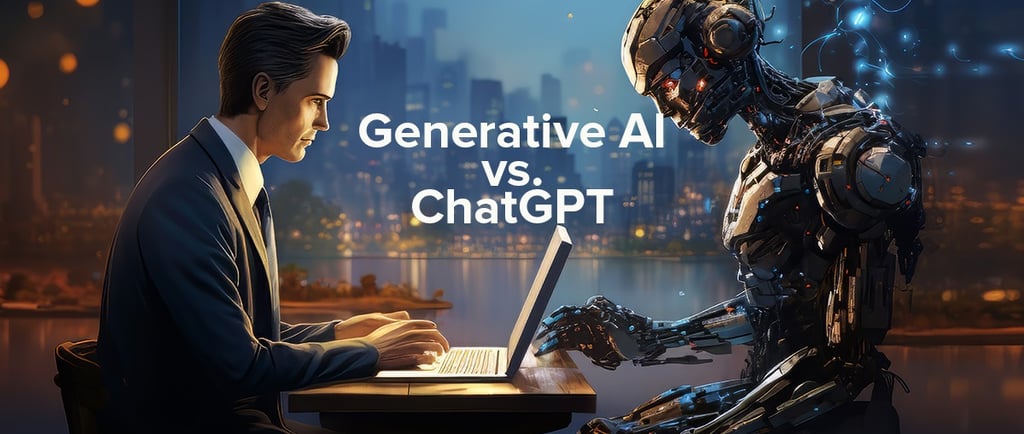Do You Know the Technology Behind ChatGPT and Generative AI
#ChatGPT, #GenerativeAI, #OpenAI, #ArtificialIntelligence, #GPTModel, #AIExplained, #TransformerArchitecture, #MachineLearning, #FutureOfAI, #HowChatGPTWorks, #DigitalAssistant, #LanguageModel, #TechnologyToday, #AIEthics, #AIForGood, #ModernTech, #EducationWithAI, #AIRevolution, #Innovation, #UnderstandingAI
TECH & SCIENCE
7/26/20253 min read


Artificial Intelligence (AI) has been revolutionizing our world—from smart assistants to self-driving cars. But in recent years, a new kind of AI has captured public imagination: Generative AI. One of its most popular creations is ChatGPT, a conversational AI that can write stories, solve problems, code software, and more. But do you know how ChatGPT actually works and what powers its incredible abilities?
1. What Is Generative AI?
Generative AI refers to a type of artificial intelligence that can generate content—text, images, audio, video, or code—by learning from vast amounts of existing data. Unlike traditional AI, which only analyzes data or classifies it, generative AI creates new, original content.
Examples include:
ChatGPT (text)
DALL·E (images)
Sora (videos)
MusicGen (audio)
2. How ChatGPT Works: The Basics
ChatGPT is built on a model called GPT (Generative Pre-trained Transformer), developed by OpenAI. The GPT architecture is a type of large language model (LLM) trained on massive datasets—books, websites, research articles, and other text.
Its core functions include:
Understanding input: It breaks down what you write into tokens.
Context processing: Uses attention mechanisms to understand meaning.
Generating response: Predicts the next best word or token based on input.
It’s like a supercharged autocomplete—but one that’s read billions of pages first!
3. Transformer Architecture: The Secret Sauce
At the heart of ChatGPT lies a groundbreaking innovation from 2017: the Transformer model.
Key features include:
Self-attention mechanism: Allows the model to focus on different parts of the input at once.
Multi-layered processing: Deeper layers understand more abstract meanings.
Parallel processing: Faster training and response generation.
Transformers replaced older models like RNNs and LSTMs due to their speed and scalability.
4. Pre-Training and Fine-Tuning
ChatGPT learns in two main stages:
a) Pre-training:
The model is trained on huge amounts of text from the internet.
It learns grammar, facts, reasoning patterns, and language structure.
b) Fine-tuning:
It’s then refined with human feedback, using methods like Reinforcement Learning from Human Feedback (RLHF).
This ensures the model avoids harmful responses and aligns better with human values.
5. How Does It Answer Questions So Well?
ChatGPT doesn’t “know” facts like a human—it predicts what is most likely to come next based on training. Its intelligence is statistical:
It breaks down your query into tokens (parts of words).
It scans your input and compares it with patterns it has seen before.
It generates a response based on probability and context.
So when it answers, it’s drawing on a vast web of associations learned during training.
6. The Role of Tokens and Context
ChatGPT processes text in tokens—chunks of words. Each version (GPT-3.5, GPT-4, etc.) has a token limit, which affects how much it can "remember" in a conversation.
GPT-3.5: ~4,000 tokens
GPT-4: Up to 128,000 tokens (depending on configuration)
This means more context allows for deeper, smarter conversations.
7. Evolution of GPT Models
Here’s a snapshot of how GPT evolved:
GPT-1 (2018): 117 million parameters
GPT-2 (2019): 1.5 billion parameters
GPT-3 (2020): 175 billion parameters
GPT-4 (2023): Multimodal, accepts text and images
Each version significantly improved in understanding, coherence, and creativity.
8. Safety, Ethics, and Limitations
Despite its power, ChatGPT has limitations:
It may hallucinate facts (make things up).
It reflects biases in its training data.
It’s not sentient—it doesn’t have beliefs or consciousness.
OpenAI has invested heavily in alignment research, safety layers, and usage monitoring to reduce risks.
9. Real-World Applications of Generative AI
ChatGPT and generative AI are already changing the world:
Education: Personalized tutoring, summaries, exam prep
Healthcare: Document generation, symptom analysis
Programming: Code suggestions, debugging
Marketing: Ad copy, content strategy
Creativity: Story writing, poetry, visual art generation
Generative AI saves time, boosts creativity, and enhances productivity across industries.
10. The Future of ChatGPT and Generative AI
The future includes:
Multimodal AI: Chat with images, videos, and audio.
Personal AI Assistants: Tools that understand your preferences deeply.
AI in every tool: From Google Docs to medical devices.
ChatGPT will continue evolving with better memory, faster processing, and more personalization.
Conclusion
The technology behind ChatGPT is both astonishingly complex and beautifully elegant. It showcases the power of machine learning, the genius of human engineering, and the limitless potential of AI when guided ethically. While it’s not perfect, ChatGPT represents the beginning of a new era—where humans and machines collaborate to understand and build a smarter future.
Knowledge
Empowering minds with reliable educational content daily.
Newsletter Signup
© 2025 DoYouKnow. All rights reserved.
Stay Ahead of the Trends – Join Our Newsletter
